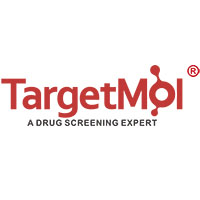| Name | NU 7026 |
| Description | NU 7026 (DNA-PK Inhibitor II) is an effective DNA-PK inhibitor (IC50: 0.23 μM, in cell-free assays), 60-fold selective for DNA-PK than PI3K and no inhibition against both ATM and ATR. |
| Cell Research | NU7026 is dissolved in DMSO and stored, and then diluted with appropriate media before use[2]. I83 cells are plated in RPMI 1640 medium with 10% FBS (1.5×105 cells/mL) and treated with vehicle (DMSO), 5 μM CLB, CLB IC50, 10 μM NU7026, or the combination of both drugs for 0, 6, 24, and 48 h. Cell cycle distribution, apoptosis, DNA-PK phosphorylation, and γH2AX determination are determined, and they are expressed as a percentage of cells in each phase of the cycle. DNA content is analyzed with a FACSCalibur flow cytometer equipped with CellQuest software[2]. |
| Kinase Assay | Mammalian DNA-PK (500 ng/μL) is isolated from HeLa cell nuclear extract after chromatography using Q-Sepharose, S-Sepharose, and Heparin agarose. DNA-PK (250 ng) activity is measured at 30°C, in a final volume of 40 μL, in buffer containing 25 mM HEPES (pH 7.4), 12.5 mM MgCl2, 50 mM KCl, 1 mM DTT, 10% v/v Glycerol, 0.1% w/v NP-40, and 1 mg of the substrate GST-p53N66 (the NH2-terminal 66 amino acid residues of human wild-type p53 fused to glutathione S-transferase) in polypropylene 96-well plates. To the assay mix, varying concentrations of inhibitor (in DMSO at a final concentration of 1% v/v) are added. After 10 min of incubation, ATP is added to give a final concentration of 50 μM, along with a 30-mer double-stranded DNA oligonucleotide (final concentration of 0.5 ng/mL), to initiate the reaction. After 1 h with shaking, 150 μL of PBS are added to the reaction, and 5 μL are then transferred to a 96-well opaque white plate containing 45 μL of PBS per well, where the GSTp53N66 substrate is allowed to bind to the wells for 1 h. To detect the phosphorylation event on the serine 15 residue of p53 elicited by DNA-PK, a p53 phosphoserine-15 antibody is used in a basic ELISA procedure. An antirabbit horseradish peroxidase-conjugated secondary antibody is then used in the ELISA before the addition of chemiluminescence reagent to detect the signal as measured by chemiluminescent counting via a TopCount NXT[1]. |
| In vitro | The bioavailability of NU7026, administered intraperitoneally (i.p.) or orally (p.o.) at a dose of 20 mg/kg, was found to be 20% and 15%, respectively. In mice, NU7026 administered intravenously (i.v.) at the same dosage exhibited a rapid plasma clearance rate of 0.108/h. |
| In vivo | NU7026 inhibits DNA DSB repair in the V3YAC cell line by 56%. In the CLL cell line (I83) and primary CLL lymphocytes, NU7026 exhibits synergistic cytotoxic activity with Bendamustine at concentrations below 10 μM. In K562 cells, NU7026 (10 μM) enhances the growth inhibitory effects of doxorubicin, amsacrine, idarubicin, aminobenzotriazole, etoposide, and mitoxantrone, with PF50 values ranging approximately from 19 (for mAMSA) to 2 (for idarubicin). Also, at 10 μM, NU7026 enhances the growth inhibition induced by etoposide in leukemia cells (PF50: 10.53) and the etoposide-induced G2 phase cell cycle arrest in K562 cells. A 4-hour exposure to NU7026 (10 μM) combined with 3 Gy radiation is necessary for a significant radiosensitization effect in CH1 human ovarian cancer cells. In the I83 cell line, NU7026 (10 μM) increases G(2)/M phase arrest and γH2AX throughout the cell cycle, both induced by Bendamustine, as well as apoptosis. Finally, at 55 μM, NU7026 notably induces telomere fusion in p53-deficient MEFs and causes less telomere fusion in MEFs lacking both p53 and Ligase IV. |
| Storage | Powder: -20°C for 3 years | In solvent: -80°C for 1 year | Shipping with blue ice. |
| Solubility Information | DMSO : 2.8 mg/mL (10 mM)
|
| Keywords | DNA-dependent protein kinase | inhibit | Apoptosis | NU 7026 | DNA-PK | Inhibitor | LY-293646 | NU-7026 | LY 293646 |
| Inhibitors Related | Stavudine | 5-Fluorouracil | Acetylcysteine | Kaempferol | Myricetin | Sodium 4-phenylbutyrate | L-Ascorbic acid | Dextran sulfate sodium salt (MW 4500-5500) | Metronidazole | Sorafenib | Tributyrin | Lidocaine hydrochloride |
| Related Compound Libraries | Anti-Colorectal Cancer Compound Library | Reprogramming Compound Library | Bioactive Compound Library | Kinase Inhibitor Library | Anti-Obesity Compound Library | Anti-Breast Cancer Compound Library | Inhibitor Library | Stem Cell Differentiation Compound Library | Anti-Aging Compound Library | Bioactive Compounds Library Max |

 United States
United States



